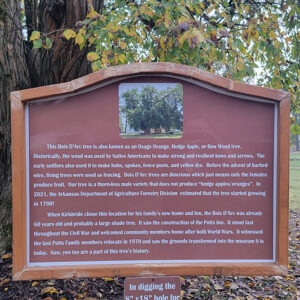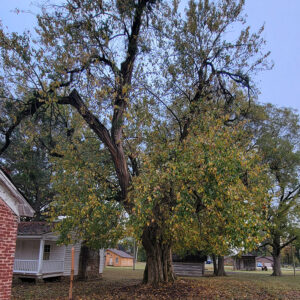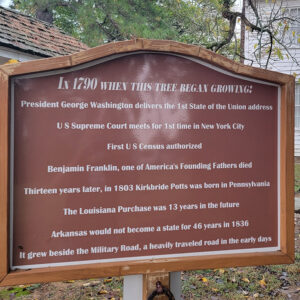calsfoundation@cals.org
Bodark
aka: Osage Orange
aka: Maclura pomifera
aka: Bois d'Arc
aka: Horse Apple
aka: Hedge Apple
The bodark tree (Maclura pomifera) is a common tree in Arkansas, known to live in at least forty-seven of the state’s seventy-five counties. The name “bodark” is a slurring of the French “bois d’arc,” meaning “wood of the bow”—a reference to the Osage Indians’ practice of making bows from the tree. The Osage connection survives in another common appellation, Osage orange, which refers to the unique fruit of the tree, as do other names, such as horse apple and hedge apple.
Native to the area encompassing Arkansas, Texas, Oklahoma, Missouri, and Kansas, the bodark tree was among those described by William Dunbar of the Hunter-Dunbar Expedition while proceeding to the Ouachita River. French explorers had already encountered the Osage using the wood of the tree to make longbows and various other weapons. Indeed, its wood is still quite valuable due to its density, which makes it suitable for everything from fence posts to artistic woodcarving. In addition, the bodark is renowned for its suitability in making natural fences, hedgerows, or windbreaks, and many farmers planted rows of trees for just such purposes; too, the wood is not prone to decay, so even when it was twisted or crooked, it was still valuable for use in making fence posts. Until the advent of cheap barbed wire in the 1880s, bodark seedlings from Arkansas were sold far and wide for use in growing hedges, especially in the Midwest. The William Stromberg Nursery in Fort Smith (Sebastian County) and the White River Hedge Co. in Augusta (Woodruff County) grew from the trade in bodark seedlings. In the 1940s and 1950s, the Ben Pearson Archery in Pine Bluff (Jefferson County) used bodark wood in its bows, hearkening back to the origin of the tree’s name. According to folklore, bodark fruit repels numerous insects, including spiders and cockroaches, and researchers at the University of Iowa in the late 1990s found present in it chemical compounds that act as a natural insect repellent.
The fruit of the bodark, by which the tree receives some of its more common names, is structured like the fruit of the bodark’s cousin, the mulberry, consisting of a collection of seed drupelets, though it is green and approximately five inches in diameter. When cut, it exudes a milky sap. Squirrels and opossums can be seen eating bodark fruit in the wild, and horses are known to eat them when available, though the fruit constitutes a real choking hazard for horses. The strange dearth of animals that actively pursue the fruit has led some scientists to theorize that the bodark is an anachronism, perhaps having evolved so that its fruit was delectable to some now-extinct creature such as the mastodon. When these creatures became extinct, the bodark tree, which at one time covered much of North America, also went into decline.
For additional information:
Barlow, Connie. The Ghosts of Evolution: Nonsensical Fruit, Missing Partners, and Other Ecological Anachronisms. New York: Basic Books, 2002.
Brown, Allan. “The Uncommon Bodark.” Arkansas Times, May 1986, pp. 50–55.
Dillard, Tom. “Bodark Began to Bow Out after Mastodons Bit the Dust.” Arkansas Democrat-Gazette. February 16, 2003, p. 5H.
———. “Resilient Bodark Tree Has Roots in State’s History.” Arkansas Democrat-Gazette. November 17, 2002, p. 5H.
“Osage Orange.” Great Plains Nature Center. https://gpnc.org/flora/osage-orange/?msclkid=f23051fcc65511ecabffdb4476636072 (accessed April 27, 2022).
Staff of the CALS Encyclopedia of Arkansas
 Bois D'Arc Tree
Bois D'Arc Tree  Bois D'Arc Tree
Bois D'Arc Tree  Bois D'Arc Tree
Bois D'Arc Tree 




Comments
No comments on this entry yet.